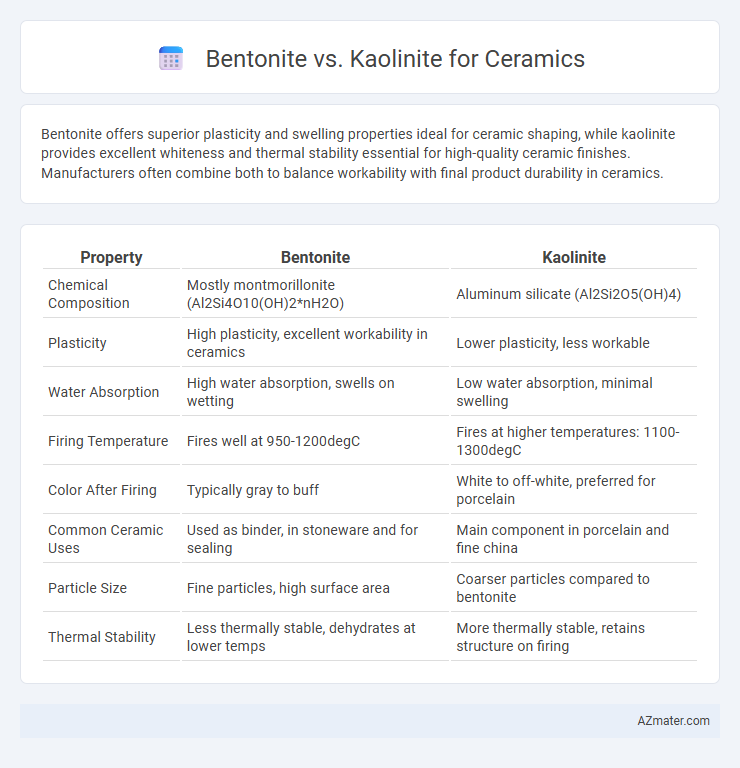Bentonite offers superior plasticity and swelling properties ideal for ceramic shaping, while kaolinite provides excellent whiteness and thermal stability essential for high-quality ceramic finishes. Manufacturers often combine both to balance workability with final product durability in ceramics.
Table of Comparison
| Property | Bentonite | Kaolinite |
|---|---|---|
| Chemical Composition | Mostly montmorillonite (Al2Si4O10(OH)2*nH2O) | Aluminum silicate (Al2Si2O5(OH)4) |
| Plasticity | High plasticity, excellent workability in ceramics | Lower plasticity, less workable |
| Water Absorption | High water absorption, swells on wetting | Low water absorption, minimal swelling |
| Firing Temperature | Fires well at 950-1200degC | Fires at higher temperatures: 1100-1300degC |
| Color After Firing | Typically gray to buff | White to off-white, preferred for porcelain |
| Common Ceramic Uses | Used as binder, in stoneware and for sealing | Main component in porcelain and fine china |
| Particle Size | Fine particles, high surface area | Coarser particles compared to bentonite |
| Thermal Stability | Less thermally stable, dehydrates at lower temps | More thermally stable, retains structure on firing |
Introduction to Bentonite and Kaolinite in Ceramics
Bentonite and kaolinite are essential clay minerals widely used in ceramics due to their unique properties and compositions. Bentonite, rich in montmorillonite, provides excellent plasticity and water absorption, making it ideal for molding and shaping ceramic products. Kaolinite, with its fine particle size and low shrinkage, offers superior whiteness and strength, crucial for producing high-quality porcelain and fine ceramics.
Chemical Composition: Bentonite vs Kaolinite
Bentonite primarily consists of montmorillonite, a smectite group clay mineral rich in silica (SiO2), alumina (Al2O3), and a significant amount of exchangeable sodium or calcium ions, which contribute to its swelling properties. Kaolinite is an aluminosilicate mineral with the formula Al2Si2O5(OH)4, characterized by a layered structure containing silica and alumina in nearly equal proportions, with minimal swelling capacity. The high cation exchange capacity and swelling behavior of bentonite contrast with the chemically stable, low-reactivity nature of kaolinite, influencing their respective uses in ceramic formulations.
Physical Properties Comparison
Bentonite exhibits high plasticity and swelling capacity due to its montmorillonite mineral content, making it ideal for shaping and molding in ceramics. Kaolinite features lower plasticity and minimal shrinkage during firing, resulting in a more stable and less deformable ceramic body. The particle size of bentonite is finer than kaolinite, enhancing workability while kaolinite offers superior whiteness and thermal stability for finished ceramic products.
Plasticity and Workability in Ceramic Applications
Bentonite exhibits superior plasticity and workability compared to kaolinite due to its high swelling capacity and fine particle size, which enhance the clay's ability to be shaped and molded in ceramic applications. Kaolinite, although less plastic, offers dimensional stability and lower shrinkage rates, making it suitable for ceramics where rigidity and reduced warping are critical. The choice between bentonite and kaolinite depends on the balance required between flexibility during forming and strength after firing in ceramic production.
Firing Behavior and Thermal Stability
Bentonite exhibits superior plasticity and excellent water absorption, enhancing ceramic shaping but can cause significant shrinkage and deformation during firing due to its high swelling capacity. Kaolinite offers better thermal stability with minimal shrinkage and fewer cracks, making it ideal for high-temperature firing applications where dimensional accuracy is critical. The choice between bentonite and kaolinite impacts the ceramic's microstructure and firing behavior, with bentonite favoring workability and kaolinite optimizing thermal resistance and structural integrity.
Influence on Glaze and Surface Finish
Bentonite significantly enhances glaze suspension and application due to its high plasticity and swelling properties, resulting in smoother, more even surfaces with fewer defects in ceramic finishes. Kaolinite contributes to glaze durability and whiteness, providing a matte or satin surface texture while reducing shrinkage and improving thermal stability during firing. The combined use of bentonite and kaolinite optimizes glaze adhesion and surface finish quality by balancing plasticity with structural integrity in ceramic formulations.
Water Absorption and Porosity Differences
Bentonite exhibits higher water absorption and greater porosity compared to Kaolinite due to its montmorillonite-rich structure, which allows extensive swelling and water retention ideal for ceramic shaping and plasticity. Kaolinite has lower porosity and water absorption, attributed to its compact, layered silicate composition, resulting in denser ceramic bodies with improved strength but reduced workability. These differences influence the drying, firing behavior, and final mechanical properties of ceramic products, guiding material selection based on specific water retention and porosity requirements.
Cost and Availability for Ceramic Production
Bentonite offers greater availability and lower cost compared to kaolinite, making it a preferred choice for ceramic production where economic efficiency is crucial. Kaolinite, while more specialized and providing superior whiteness and plasticity, is often more expensive and less abundant in large deposits. Ceramic manufacturers prioritize bentonite for bulk applications due to its cost-effectiveness and widespread accessibility in global clay markets.
Environmental Impact and Sustainability
Bentonite, primarily composed of montmorillonite, exhibits high swelling capacity and plasticity, making it energy-intensive to process compared to Kaolinite, which is a white, non-expanding clay with lower environmental extraction impacts. Kaolinite's lower water absorption and minimal chemical treatment requirements contribute to reduced waste and pollutant release, enhancing its sustainability profile in ceramics manufacturing. Incorporating Kaolinite can result in ceramics with a smaller carbon footprint and better recyclability, aligning with eco-friendly production goals.
Choosing the Right Clay: Bentonite or Kaolinite?
Bentonite clay offers superior plasticity and shrinkage control, making it ideal for wheel throwing and slip casting in ceramics, while kaolinite provides exceptional whiteness and refractory properties suited for porcelain and fine china. Choosing bentonite enhances workability and bisque strength, whereas kaolinite ensures a smooth, white finish with higher firing temperatures. Selecting the right clay depends on desired ceramic properties: bentonite for plasticity and strength, kaolinite for whiteness and heat resistance.

Infographic: Bentonite vs Kaolinite for Ceramic
 azmater.com
azmater.com